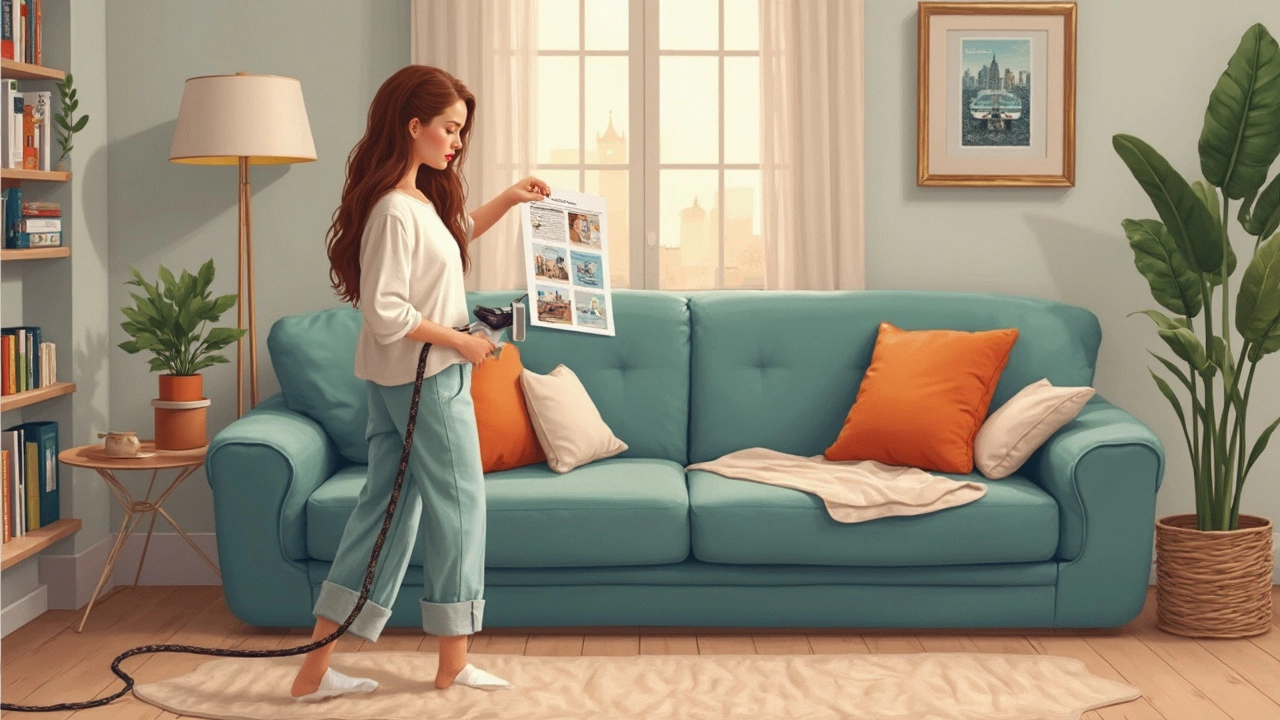Clean Couch Cushions Without Removable Covers: Practical Steps That Work

Ever tried lifting a heavy sofa just to realize the cushion covers don’t come off? You’re not alone. Most people don’t even notice their couch cushions are fixed until there’s a nasty spill or an odd smell. But don’t panic—there’s a simple way to tackle messes, even on cushions the manufacturer never intended you to open up and wash.
Forget grabbing scissors or wrestling the entire seat through a washing machine. The trick here is getting straight to the stain before it settles in. Old ketchup, pet hair, or just the everyday grime—each needs a different approach. The key is to use as little water as possible so you don’t end up with a soggy cushion or a hidden mildew problem.
- Why Removable Covers Matter (and What If You Don’t Have Them)
- Spot Cleaning: The Go-To Fix
- Deep Cleaning With Less Mess
- Odor Removal and Final Touches
Why Removable Covers Matter (and What If You Don’t Have Them)
Removable covers make cleaning couch cushions a breeze. Just unzip, toss them in the washing machine, and you’re done. But what if you’re stuck with cushions that are sewn shut? That’s the case with about 60% of sofas sold in the U.S. today—manufacturers do it so the cushions keep their shape and look uniform over time.
Why do removable covers matter so much? They let you deep-clean, remove allergens, and get rid of stubborn smells much faster. Spills are easy to fix if you can pull the cover off right away. No cover means you have to clean everything—fabric and cushion—while trying not to leave a wet mess inside.
Here’s a quick look at common types of sofa cushion construction:
| Type | Cleaning Method | Common Issues |
|---|---|---|
| Removable Cover | Machine Wash or Dry Clean | Easy stain removal, less odor buildup |
| Non-Removable Cover | Spot clean, Steam clean, Vacuum | Harder stain removal, trapped odors |
So if you don’t have removable covers, you’re not doomed. You just need a different game plan. The main thing: never soak the whole cushion. Too much water can lead to mold, weird smells, and even lumps inside the cushion. Focus on smart techniques that target the spot, dry fast, and protect the fabric. In the following sections, I’ll break down how you can clean couch cushions that don’t have removable covers—with less hassle and better results.
Spot Cleaning: The Go-To Fix
If you can’t strip off your couch covers, spot cleaning is your best bet. Actually, most furniture brands expect you to clean this way. Grab a white cloth or clean rag—they won’t transfer color to your sofa—and check the tag for the weird code: W, S, W/S, or X. This tells you what’s safe for your cushion. "W" means water-based cleaners are okay, "S" is only for solvent cleaners, "W/S" is either, and "X" says don’t use liquid—just vacuum or brush.
First step: vacuum. Seriously, don’t skip this. Dirt and crumbs grind deeper into the fabric if you rub them around, so get those out first. Next, mix a little dish soap with warm water for most “W” fabrics, or get an upholstery cleaner if it’s an “S.” Spot test your cleaner in a hidden corner. Wait for it to dry—if no weird marks show up, you’re good to go.
- Blot, don’t rub. Gently dab the clean couch cushions with your damp cloth, working from the outside of the stain inward. Rubbing just spreads the mess around.
- Stubborn stains like wine or grease? Sprinkle a bit of baking soda, wait 15 minutes, and vacuum it up. For ink, use a Q-tip dipped in rubbing alcohol—just tap lightly until the spot lifts.
- After you clean, blot the area with a dry towel to pull out extra moisture. Run a fan or open a window so the cushions dry fast—no one likes that damp smell.
Pro tip: if you’ve got weird smells lingering, lightly spritz some fabric-safe deodorizer or vinegar (diluted!) and let the area air out. That’s it. Most messes won’t need more than this, and your cushions won’t get soaked or ruined in the process.

Deep Cleaning With Less Mess
When vacuuming and dabbing at stains isn’t cutting it, you need a bigger move. Deep cleaning fixed upholstery isn’t as tough as it sounds, but there’s a right and wrong way to do it. You can’t just soak the cushion—trapped moisture can lead to mold and smells that linger for months. So, what’s the smart approach?
A handheld upholstery cleaner or a steam cleaner works wonders. According to a 2023 survey by the American Cleaning Institute, nearly 30% of home sofa owners choose a fabric-safe steam cleaner for tough messes. Why? It cleans better and dries faster than just soap and water. Always check your couch’s care label for “W,” “S,” or “WS” codes before you start, since the code tells you which cleaning agents and methods are safe.
- Vacuum thoroughly to suck up crumbs, pet hair, and loose dirt. Do a good job at the seams and under the cushions.
- Mix a solution by adding a few drops of mild dish soap to two cups of warm water for “W” or “WS” codes. If your cushion says “S,” use a dry solvent so you don’t use water at all.
- Dip a sponge or microfiber cloth into the solution, then wring most moisture out. Wipe the fabric, working in small patches. Avoid soaking it.
- If you’re using a steam cleaner, don’t hover over one spot—keep the head moving so the heat lifts dirt without saturating.
- Blot with clean, dry towels to speed up drying. Set up a fan or open windows to help, but never stack cushions until they’re 100% dry.
How long does it really need to dry? Check out this quick guide—
| Method | Average Dry Time |
|---|---|
| Soap & Water (hand wash) | 4-8 hours |
| Steam Clean | 2-4 hours |
| Dry Solvent | 1-3 hours |
Speed matters—bacteria and odor can settle into damp fabric fast. Got a stubborn smell? Sprinkling baking soda on cushions before vacuuming helps soak up musty odors. If you see leftover stains, hit them again with your cleaner, but always let the fabric dry fully between treatments. That’s the best shot at keeping your clean couch cushions from getting worse instead of better.
Odor Removal and Final Touches
Bad smells hang around on couch cushions, especially if you have kids, pets, or a love for late-night snacking. The fastest fix? Sprinkle baking soda all over the cushions and let it sit for at least 30 minutes. Baking soda eats up odors like a champ. After that, vacuum it off carefully, making sure to get into any creases or seams so nothing gets left behind.
If that doesn’t get rid of the stink, fill a spray bottle with a 1:1 mix of white vinegar and water. Give the cushion a light mist—just enough to dampen the fabric, but not saturate it. Vinegar smells strong at first but disappears as it dries, taking weird odors with it. For anyone worried about leftover smells, add a few drops of lavender or lemon essential oil to the mix.
Persistent pet smells or mystery odors? You can use an enzyme cleaner designed for upholstery. These cleaners break down odor molecules from stuff like pet accidents or spills. Just spot-test on an out-of-sight area first, in case your fabric reacts weirdly. According to a 2024 survey from the Home Cleaners of America, enzyme sprays got a 91% approval rate from pet owners dealing with couch odors.
- Let the cushion air-dry after you use any wet product. Point a fan at it for faster drying and to keep away that dreaded musty smell.
- If the cushions still smell off, set out a small bowl of activated charcoal or coffee grounds near the couch overnight—both are great at absorbing odors naturally.
- Finish by brushing the fabric with a soft upholstery brush or even a clean hand towel to fluff up the fibers. This makes your sofa look fresh and comfy instead of flattened or rough.
Need the numbers? Here’s a quick guide showing how well each deodorizer works on common couch odors (based on the same 2024 survey):
| Deodorizer | Pet Odors | Food Smells | Mildew/Mustiness |
|---|---|---|---|
| Baking Soda | Good | Great | OK |
| Vinegar Spray | OK | Good | Great |
| Enzyme Cleaner | Excellent | Good | OK |
| Charcoal/Coffee Grounds | Good | Good | Great |
Once all the hard work is done, take a minute to look over your clean couch cushions. They’ll smell better, feel nicer, and you won’t have to explain away any weird spots or lingering odors when friends drop by.
